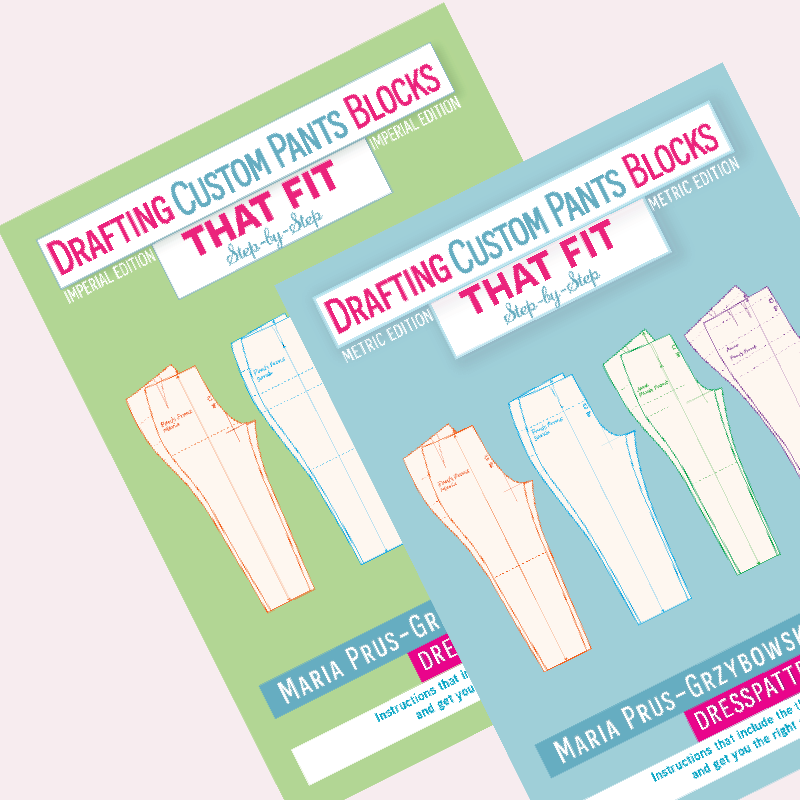Analyzing other (Bodice) Block Making Instructions: Intro
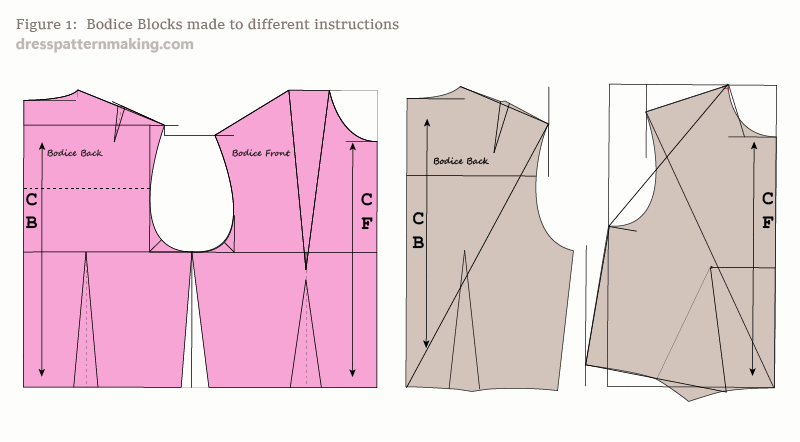
Why is a block made to my measurements so ill-fitting?
If you have a standard figure, you will probably get a good result (a reasonably well fitting block that requires only a few adjustments) from a number of block making instructions when creating a Bodice Block with Sleeve. If you have a figure that varies from the norm in a large way and in a number of ways, you may, like me, not get such a good result. In fact you may get a result so different from your figure that you are really stumped; you used your measurements to draft the block so how could it be so wrong?
I have used a number of different block making instructions in my quest to make a well-fitting Bodice block. None of them were very successful. I define success as: producing a reasonably well-fitting block that only needed minor adjustments. The adjustments required were well beyond minor. With the ill-fitting blocks I was making, there were often three or four separate fitting issues, and with my limited knowledge (beginner's) at the time, it was difficult to separate the issues and find out what was going on... I kept coming back to the question: Why was a block created to my class="emPinkBold", not fitting my body?
Make the block, then make changes according to the toile fitting!
I fully understand that a block made to any set of instructions can to be considered simply a starting point, that you can make a toile, see where the fitting issues are, and then finalize that block according to the problems encountered on that block.... But... Firstly, that is easier said than done. Secondly, isn't it better to start with a block that reflects the body that it is being made to fit as close as possible (i.e. no assumptions, such as shoulder slope, being made), so that the adjustments needed are minor, rather than major? Isn't it better to get the best fit possible from the initial block? I thought that SURELY instructions could be written that results in a reasonably well-fitting block for most figures, including individual hard-to-fit figures, rather than just the fashion industry? And couldn't the large-bust adjustment be created in the block making process?
Also - as an aside - if it is so easy to make a toile from the (ill-fitting) block, then make changes, why did I have both an experienced dressmaker and a college teacher both get it so wrong when applying that theory to my block/figure?
To illustrate this point there are two examples below. Figure 2 below compares my current well-fitting block sleeveless block (white shape) to a sleeveless block made for me by a dressmaker (pink shape). She made an initial block from standard block-making directions. She then made a toile and then did a fitting. There were many things wrong, but she marked on the toile what needed to be changed and from there made changes to the block, which she then gave to me - without a second fitting to make sure all the changes were correct. The resulting block was NOT a good fit.
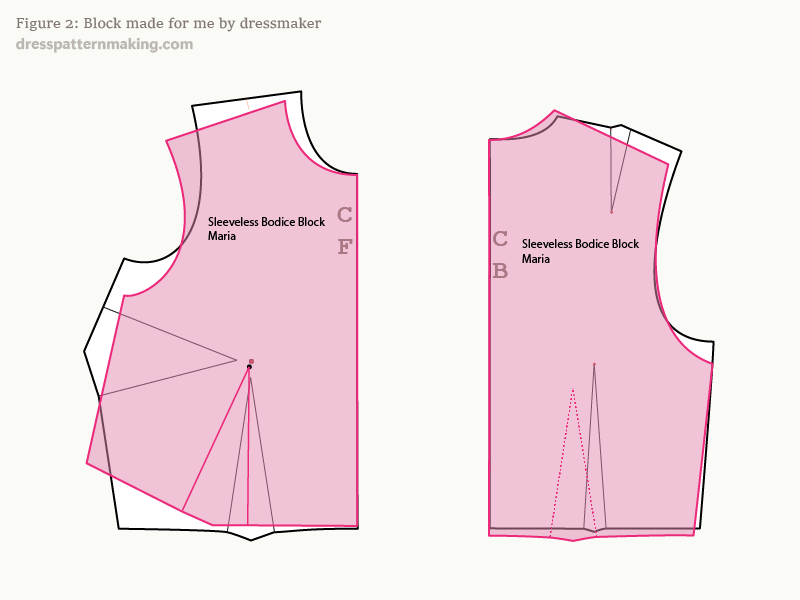
Figure 3 shows a second example. The same kind of thing happened when I signed up for a Community Collage block making class. The blocks were drafted to standard directions. Then I made a toile to see how it fit. Again, it was wrong in SO many ways.
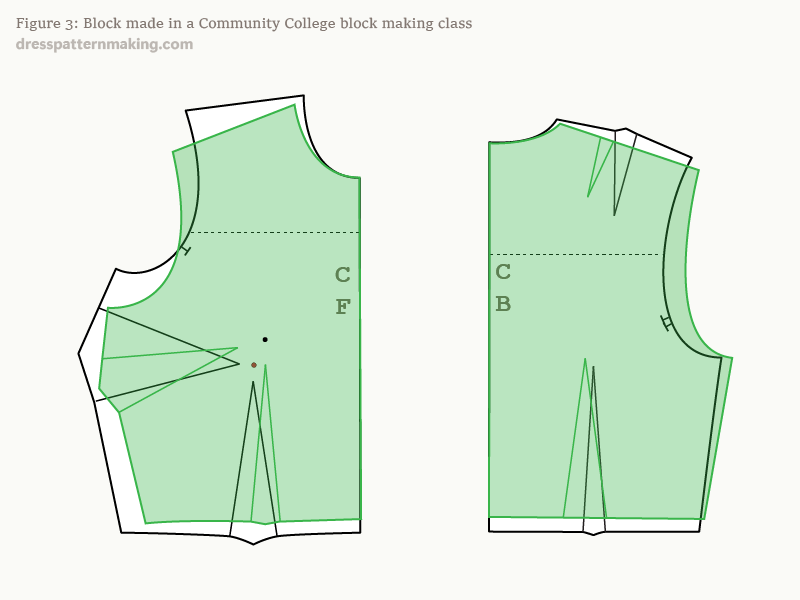
The teacher looked at my fitting issues then marked the block where changes should be made for it to fit me better. This happened in the last class so I had to do the changes she marked at home and there would be no chance to make further correciton. When I made those changes and then a toile from the corrected block - it still did not fit me. See Figure 4 for the comparison of the white block which fits me and the orange shaded block, which is the block in Figure 3 PLUS the adjustments.
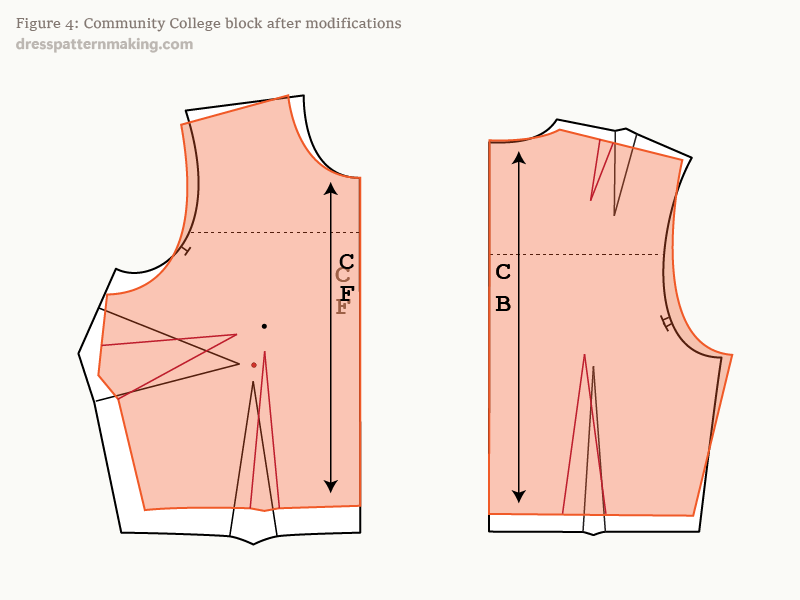
Sure, maybe I 'just' needed another fitting(?).
The thing that really puzzles me is that no large-bust adjustment was made in either case. For those who may think "maybe you don't really need a large bust adjustment, you are overestimating your bust-cup, because both a dressmaker and a classroom instructor couldn't both be wrong..." See the image of my body-cast compared to a standard dressmakers' dummy.
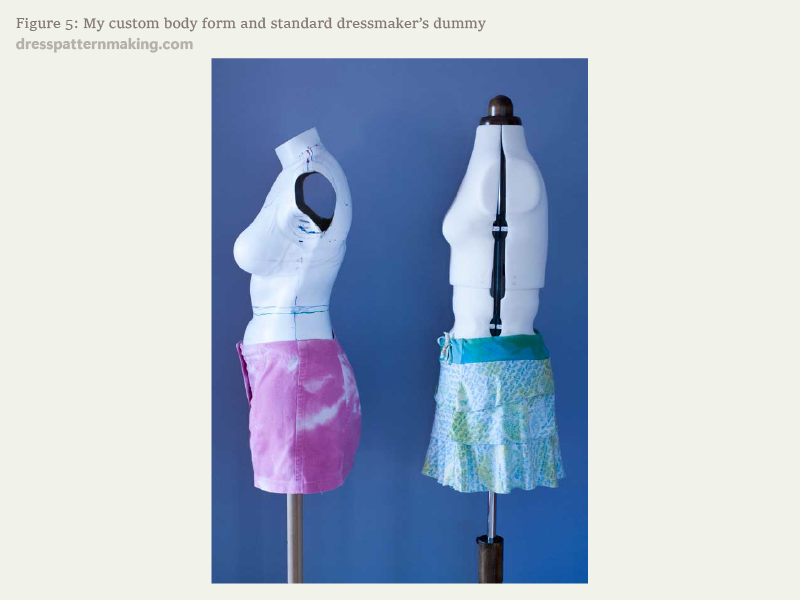
When I finally got to understand where all the issues were in my particular case, I realized that, given what I had learned in the process, I could refine the block making instructions to produce a better fitting block for non-standard figures. One of the main difference with my instructions is basing the width of the Bodice Block on the Upper Bust rather than the Bust - this eliminates problems for women with large bust-cups while making no difference to women with the standard B-cup. I also included creating the necessary bust cup within the block making process. My sleeve instructions mean that people with non standard figures end up with a sleeve that better reflects their body, rather than assuming an upright posture and symmetry.
Other things I thought I could offer was some extra information along the way, pointing out things to be careful of and where you might run into problems.
I want to stress that I am not criticizing the other authors or the other instructions or their instructions. Their focus is different to mine; their focus is not creating better fitting blocks for non-standard figures. Their focus is fashion. Fashion and the garment manufacturing industry must use a 'Standard Figure' because it would not be profitable to make clothing in different shapes as well as different sizes. They must 'pick a figure' and grade it up and down.
Most Block Making Instructions are directed at the Fashion Industry
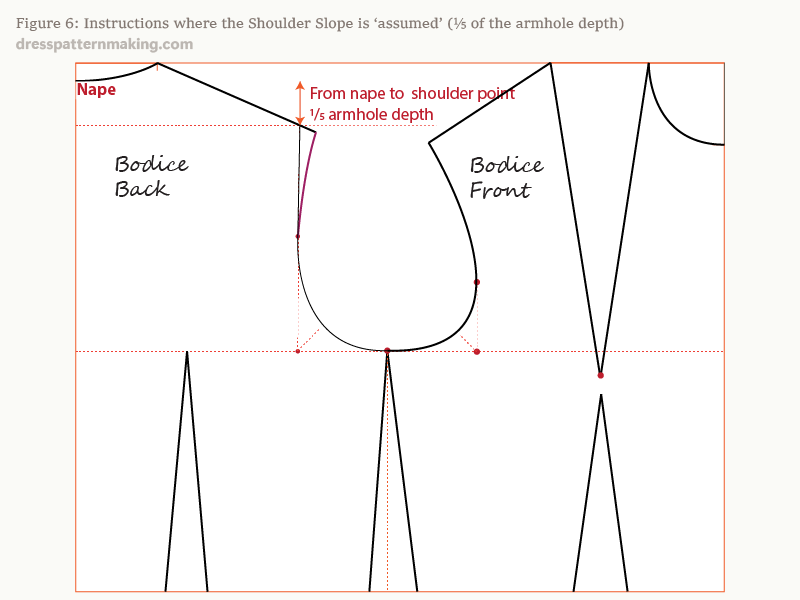
Most of these instructions are aimed at the fashion industry; this can seen in the titles of some of the books (for Fashion Design, for Fashion Designers, for Fashion...). The bottom line is that clothes designed for fashion is based on some kind of standard figure. Some fashion labels may target different body types (e.g. Apple or Pear shape rather than Hourglass), but the final blocks are still some kind of standard. Women's shoulder slope ranges from very square to very sloped; most ready to wear clothing has an in-between shoulder slope. Otherwise they wouldn't sell too many clothes if the made it for the squarest shoulders or the most sloping shoulder.
Traditionally most women had a B bust-cup, and this is probably why most (and all of the instructions I have come across) are for a B bust-cup.
Again, I understand why these instructions are the way they are: they are targeted at a particular audience. Most fashion students using these blocks would create standard blocks with them, for example, from the charts at the front of the same textbooks. Most patternmakers in fashion house aren't making individual blocks for hard-to-fit figures; they are making blocks that fit some kind of standard figure.
I also understand that these textbooks have additional instructions on how to make changes to a block to get a better fit. So if you create a block and the shoulder slope is wrong, you look up the section on how to make changes to the shoulder slope, and .... voila!
But ... what if it's possible to have instructions that produce a reasonably fitting block for all figures from the outset? Now this may require a few tips along the way (e.g. be careful of this!, there is a "gotcha" here, take this into account there, this is why we are doing this...). Others may think that these side-explanation are too hard, or unnecessary; it's much easier to just make the block, make a toile, then make the changes. Well, that may be the case for them. For others like me, who find it very difficult to see where and how the changes are to be made on the toile, may prefer to follow my instructions. Well, Horses for courses, as the saying goes....
Methods vs Instructions
There are a few different block making methods, and a lot of different block making instructions. What is the difference between methods and instructions?
A method is a system, or a set of procedures for doing something - many people may use the same method, but write their own set of instructions, using their own words and own images to explain how to achieve a result using that method. (You cannot copyright a method, you can only copyright instructions).
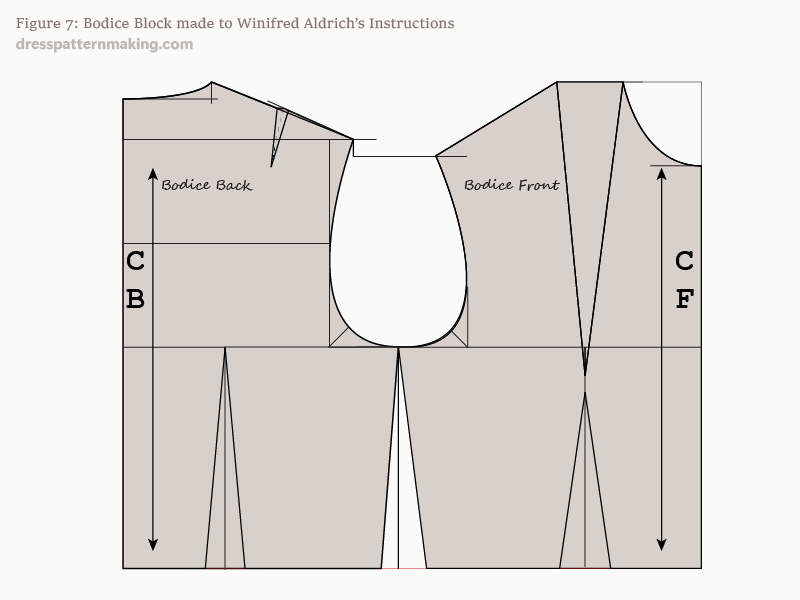
Deciding if two sets of instructions are using the same or a different method is tricky: how much do you have to change a method before it becomes a different method? That's really not important. To an extent the method matters - some have less assumptions than others and will therefore result in a better fitting block from the beginning - but the result is what counts, and that comes from a combination of the method and the instructions.
You could have two people using the same method, but one has clearer instructions, described differently, with better graphics. You can have a great method, with poorly written instructions. The bottom line is, are the instructions easy to follow, do they provide enough explanations and do they result in a reasonably well fitting block? (Assuming all measurements are correct, of course!).
Now I've already said this, but it bears repeating: You cannot copyright a method, but you can copyright instructions. What the copyright covers is the text and images in those instructions. This is why you can have a number of different authors writing instructions for the same method: the instructions they write is only copyrighted insofar as the text and the images they use. Each author writes in a different (literary) 'voice', their writing style is different, the words they use are different, the images are different... the end product is completely different. (Just as you can have two people writing an essay on the same subject; it is only a copyright violation if one of them is quoting verbatim, or using their images, etc).
My Articles: Critiques
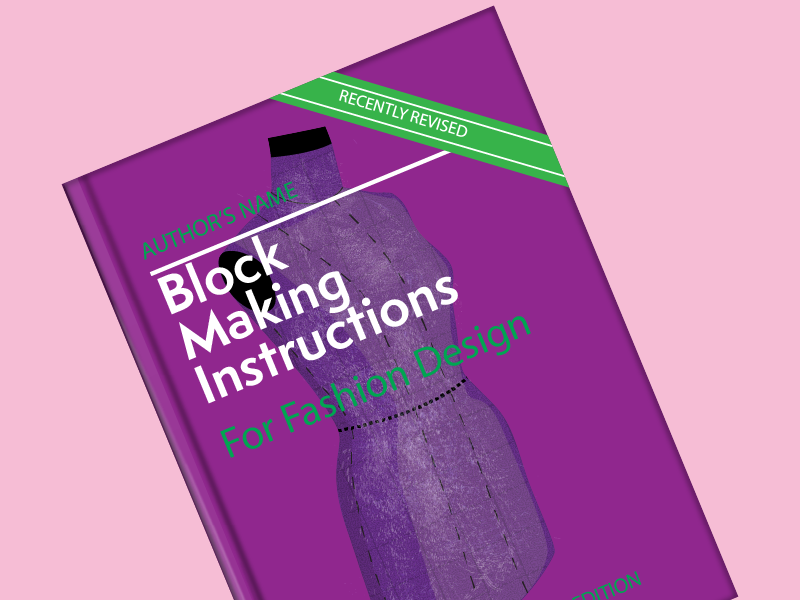
In by block-creation journey, I purchased quite a few textbooks, and acquired other instructions in the form of handouts (Esmod classes, Community College Class, a private Dressmaker, etc). I tried creating my Bodice Block using seven different sets of instructions. My conclusion (and this is my opinion), is that all of them fall broadly into two methods: what I have called (and I may be wrong), the American method (used by Joseph-Armstrong and Lori A Knowles) and the English/European method (used by Aldrich, Esmod, Gilewska, the Community College Class and a private dressmaker I started classes with). Whether this isn't actually two methods, but rather five, or six or seven (each one has a number of differences, and where do enough differences mean that it is another method?), is really a moot point. (Although I am positive that Joseph-Armstrong and Knowles use the same method!). In my opinion, what I call the American method requires more class="emPinkBold", and doesn't have (as many) assumptions. It can also be refined (which is what I did) to eliminate some of the assumptions, and clarify/avoid the problem areas. The other method - what I call the English/European method, has many assumptions built in that mean that I can't see where or how I could make changes to avoid to those issues. I have written a few articles under this Menu (Looking at other Block Making Instructions) for the purpose of showing where must of the assumptions are made within block making instructions, and what this means for non-standard figures. Giving specific examples showing just how much work is involved in adjusting the block/toile to fit. For these critiques I have chosen two authors that use distinctly different methods: Joseph-Armstrong's instructions (American method) and Winifred Aldrich's instructions (English/European method). Most of the issues that are found in these two sets of instructions are common in the others. For example: I wanted to cover the issue of the Assumed Shoulder Slope. This is found in Winifred Aldrich's instructions, as well as Teresa Gilewska's, and Esmod. The bottom line is, I want to show that it's possible to start with less assumptions, and improve the outcome for people with non-standard figures. Now the American method already has it over the English method in spades: for example, it doesn't assume the shoulder slope. But there are still a few changes that can be made that will improve the outcome for people with non-standard figures.
Reference Books (and Handouts)
These are most of the block making instructions I have used:
- Aldrich, Winified: Metric Pattern Cutting, Third Edition (Revised), 1997
- Joseph-Armstrong, Helen: Patternmaking for Fashion Design, Fourth Edition
- Esmod: Instructions given to students in a class in Sydney, 2009
- Gilewska, Teresa: Pattern Drafting for Fashion: The Basics, 2008
- Knowles, Lori A: Patternmaking for Fashion Designers: Juniors, Misses, and Women, 2005
- Unknown Author: Community College Class instructions, Author unspecified
The articles where I write about the problems I encountered with Joseph-Armstrong and Aldrich's instructions, was using the above editions. However, they have subsequently published updated editions:
- Aldrich, Winifred: Metric Pattern Cutting for Women's Wear, 5th Edition, 2008
- Joseph-Armstrong, Helen: Patternmaking for Fashion Design, Fifth Edition
My method and instructions
I found that (what I call) the American method is the best method. It has less assumptions. I use this method, but my instructions are different in these ways:
- For the Bodice Block I use the Upper Bust rather than the Bust as the basis for the block
- You create the dart you need for your bust-cup within the instructions (rather than having to do a Large Bust Adjustment afterwards)
- Obviously I have created my own graphics and write the instructions in my words
- my instructions are more incremental (rather than have all steps on one page, I show two or three steps in one image before moving on)
- The Sleeve Block does not assume symmetry
- I use a different way to determine the Front Armhole Depth than do Armstrong and Knowles
- I point out things to watch out for on the way (e.g. you may end up with an incorrect measurement when measuring the Across Shoulder....

